How to recognise and avoid modern spam emails
Avoiding spam emails is easier than ever, because ISPs have invested huge amounts of time and energy in combating them.

When was the last time you received a spam email?
In all probability, the answer is not recently. Yet spam hasn’t gone away – recent figures suggest 85 cent of all emails sent every day are spam.
The increasing novelty of actually receiving a “Dearest Friend” email or an invitation to claim your $314,000,000 lottery win is not because spammers have got bored and moved on.
Instead, it’s thanks to Herculean efforts by internet service providers.
ISPs and email platforms invest heavily in preventing junk mail either at source or in cyberspace, avoiding spam emails cluttering up your inbox.
Yet the messages themselves have evolved to become increasingly sophisticated…
Spam spam spam
Back when the term spam referred to either tinned meat or a Monty Python sketch, a military communications network called ARPANET served as the forefather of the internet.
In 1978, a commercial spam email was sent to several hundred ARPANET users, but it would be another 15 years before the term ‘spam’ was applied to unwanted messages.
Early examples of spam tended to be promotional messages for legitimate content, but by the late 1990s, the meteoric growth in internet usage had led to email being used for malware.
This saw computers around the world being infected with everything from worms and Trojans to ransomware.
Suddenly, spam email wasn’t merely an annoyance. It was actively dangerous.
Pump up the volume
The volume of spam email increased exponentially throughout the febrile first decade of widespread internet adoption, until inboxes were groaning under the weight of junk mail.
ISPs and email providers were worried their customers would abandon email entirely, so they developed filters to identify unwanted missives by the appearance of certain words or phrases.
The word ‘Viagra’ had been synonymous with junk mail for years, but the filters evolved to recognise deliberate misspellings such as ‘V1agra” or “v!agra”.
This was an early example of spam evolving to circumvent filters which are themselves constantly being refined, in a game of cat-and-mouse which continues to this day.
The staggering volume of spam sent every day reflects the fact that its senders only need a miniscule proportion of people to respond.
A 2008 survey calculated that a response rate of 0.00000008 per cent was enough for spammers to turn a profit.
Refinements to the recipe
These are some of the comparatively advanced tricks spammers use nowadays. Recognising and understanding them should help in terms of avoiding spam emails…
Familiar senders. Spam might claim to have been sent by celebrities or public figures, as recipients are more likely to open mail from names they subconsciously recognise.
Hot topics. Seasonal events like Christmas often see spikes in related spam messages, as do high-profile product launches or sporting events such as last weekend’s World Cup Final.
Fraudulent verification requests. “Your parcel could not be delivered” is a classic attempt to encourage people to submit personal information through a compromised website.
Urgency. If people panic, they’re less likely to recognise a trick. Spam emails often claim a payment has been refused or an account suspended, urging people to respond now.
The best advice in terms of avoiding spam emails is to approach any unsolicited message with suspicion. Never open attachments or click on hyperlinks unless you trust them.
After all, spam filters and algorithmic analysis can only accomplish so much…






